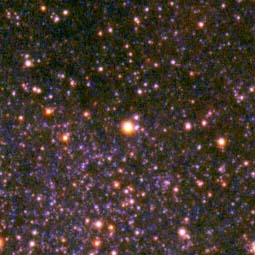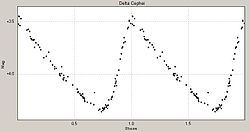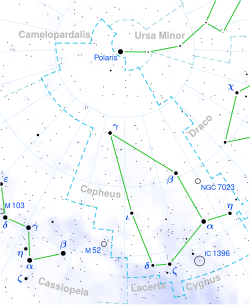Delta Cephei
| Stern Delta Cephei | |||||||||||||||||||||
|---|---|---|---|---|---|---|---|---|---|---|---|---|---|---|---|---|---|---|---|---|---|
 | |||||||||||||||||||||
| AladinLite | |||||||||||||||||||||
| Beobachtungsdaten Äquinoktium: J2000.0, Epoche: J2000.0 | |||||||||||||||||||||
| Sternbild | Kepheus | ||||||||||||||||||||
| Rektaszension | 22h 29m 10,27s [1] | ||||||||||||||||||||
| Deklination | +58° 24′ 54,7″ [1] | ||||||||||||||||||||
| Helligkeiten | |||||||||||||||||||||
| Scheinbare Helligkeit | 3,75 (3,49 bis 4,36) mag [2][3] | ||||||||||||||||||||
| Spektrum und Indices | |||||||||||||||||||||
| Veränderlicher Sterntyp | DCEP[3] | ||||||||||||||||||||
| B−V-Farbindex | +0,60 [2] | ||||||||||||||||||||
| U−B-Farbindex | +0,36 [2] | ||||||||||||||||||||
| Spektralklasse | F5 Iab (F5Ib - G1Ib) | ||||||||||||||||||||
| Astrometrie | |||||||||||||||||||||
| Radialgeschwindigkeit | −24 km/s [1] | ||||||||||||||||||||
| Parallaxe | Hip: 3,77 ± 0,16 mas HST: 3,66 ± 0,15 mas [1] | ||||||||||||||||||||
| Entfernung | 887 ± 26 Lj 272 ± 8 pc [4][5] | ||||||||||||||||||||
| Visuelle Absolute Helligkeit Mvis | −3,47 ± 0,10 mag | ||||||||||||||||||||
| Eigenbewegung | |||||||||||||||||||||
| Rek.-Anteil: | 15,35 mas/a | ||||||||||||||||||||
| Dekl.-Anteil: | 3,52 mas/a | ||||||||||||||||||||
| Physikalische Eigenschaften | |||||||||||||||||||||
| Masse | 4,5 M☉ [6] | ||||||||||||||||||||
| Radius | 44,5 R☉ [6] | ||||||||||||||||||||
| Leuchtkraft | |||||||||||||||||||||
| Effektive Temperatur | 5500–6800 K | ||||||||||||||||||||
| Metallizität [Fe/H] | +0,08 [7] | ||||||||||||||||||||
| Rotationsdauer | 40 d [8] | ||||||||||||||||||||
| Alter | 108 a | ||||||||||||||||||||
| Andere Bezeichnungen und Katalogeinträge | |||||||||||||||||||||
| |||||||||||||||||||||
Delta Cephei ist ein veränderlicher Stern im Sternbild Kepheus, dessen Veränderlichkeit 1784 vom englischen Astronomen John Goodricke entdeckt wurde.
Eigenschaften


Delta Cephei ist ein gelber Überriese, der sich in einer Entfernung von 272 Parsec (887 Lichtjahren) von der Sonne befindet. Seine scheinbare Helligkeit schwankt mit einer Periode von 5,36643 Tagen zwischen 3,48m und 4,37m, wobei sich auch sein Spektraltyp zwischen F5Ib und G2Ib verändert. Damit ist eine periodische Änderung der Oberflächentemperatur um etwa 1000 °C verbunden.
Delta Cephei ist der Prototyp einer Klasse von pulsationsveränderlichen Sternen, den sogenannten Delta-Cephei-Sternen, die – da ihre Periodendauer nur von der Leuchtkraft abhängt – bei der Entfernungsmessung von Galaxien eine Rolle spielen.
Delta Cephei ist auch ein schon im Prismenfernglas trennbarer Doppelstern. Sein Begleitstern befindet sich bei einem Positionswinkel von 191° 41" von Delta Cephei entfernt. Er hat eine scheinbare Helligkeit von 6,3m und gehört der Spektralklasse B7 an.
Weblinks
- Jim Kaler: Delta Cephei. In: University of Illinois. STARS, abgerufen am 13. Oktober 2017.
- Delta Cephei, 27 Cephei. In: SEDS. Abgerufen am 21. Juni 2008.
- Delta Cephei. In: American Association of Variable Star Observers. September 2000, archiviert vom am 8. Juni 2008; abgerufen am 21. Juni 2008.
- Delta Cephei. In: The Internet Encyclopedia of Science. Abgerufen am 21. Juni 2008.
Einzelnachweise
- ↑ a b c F. van Leeuwen: Validation of the new Hipparcos reduction. In: Astronomy and Astrophysics. 474. Jahrgang, Nr. 2), November 2007, S. 653–664, doi:10.1051/0004-6361:20078357, arxiv:0708.1752, bibcode:2007A&A...474..653V.
- ↑ a b c del Cep. In: SIMBAD. Centre de Données astronomiques de Strasbourg, abgerufen am 16. September 2018.
- ↑ a b del Cep. In: VSX. AAVSO, abgerufen am 16. September 2018.
- ↑ G. Fritz Benedict, et al.: Astrometry with the Hubble Space Telescope: A Parallax of the Fundamental Distance Calibrator δ Cephei. In: Astronomical Journal. 2002, doi:10.1086/342014, arxiv:astro-ph/0206214, bibcode:2002AJ....124.1695B.
- ↑ D. Majaess, D. Turner, W. Gieren: New Evidence Supporting Cluster Membership for the Keystone Calibrator Delta Cephei. In: Astrophysical Journal. 747. Jahrgang, Nr. 2, 2012, S. 145, doi:10.1088/0004-637X/747/2/145, arxiv:1201.0993, bibcode:2012ApJ...747..145M.
- ↑ a b c L. D. Matthews, et al.: New Evidence for Mass Loss from δ Cephei from H I 21 cm Line Observations. In: The Astrophysical Journal. 744. Jahrgang, Nr. 1, Januar 2012, S. 53, doi:10.1088/0004-637X/744/1/53, arxiv:1112.0028, bibcode:2012ApJ...744...53M.
- ↑ M. A. T. Groenewegen: Baade-Wesselink distances and the effect of metallicity in classical cepheids. In: Astronomy and Astrophysics. 488. Jahrgang, Nr. 1, September 2008, S. 25–35, doi:10.1051/0004-6361:200809859, arxiv:0807.1269, bibcode:2008A&A...488...25G.
- ↑ Akira Uesugi, Ichiro Fukuda: Catalogue of rotational velocities of the stars. In: Contributions from the Institute of Astrophysics and Kwasan Observatory (University of Kyoto). 1970, bibcode:1970crvs.book.....U.
Auf dieser Seite verwendete Medien
This image layout illustrates how NASA's Spitzer Space Telescope was able to show that astandard candle" used to measure cosmological distances is shrinking -- a finding that affects precise measurements of the age, size and expansion rate of our universe. The image on the left, taken by Spitzer in infrared light, shows Delta Cephei, a type of standard candle used to measure the distances to galaxies that are relatively close to us. Cepheids like this one are the first rungs on the so-called cosmological distance ladder -- a tool needed to measure farther and farther distances.
Spitzer showed that the star has a bow shock in front of it. This can be seen as the red arc shape to the left of the star, which is depicted in blue-green (the colors have been assigned to specific infrared wavelengths we can't see with our eyes). The presence of the bow shock told astronomers that Delta Cephei must have a wind that is forming the shock. This wind is made up of gas and dust blowing off the star. Before this finding, there was no direct proof that Cepheid stars could lose mass, or shrink.
The finding is important because the loss of mass around a Cepheid can obscure the star's light, making it appear brighter in infrared observations, and dimmer in visible light, than it really is. This, in turn, affects calculations of how far away the star is. Even tiny inaccuracies in such distant measurements can cause the whole cosmological distance ladder to come unhinged.
The diagram on the right illustrates how Delta Cephei's bow shock was formed. As the star speeds along through space, its wind hits interstellar gas and dust, causing it to pile up in the bow shock. A companion star to Delta Cephei, seen just below it, is lighting up the region, allowing Spitzer to better see the region. By examining the structure of the bow shock, astronomers were able to calculate how fast the star is losing mass.
In this image, infrared light captured by the infrared array camera is blue and blue-green (3.6- and 4.5-micron light is blue and 8.0-micron light is blue-green). Infrared light captured by the multiband imaging photometer is colored green and red (24-micron light is green and 70-micron light is red).Autor/Urheber: Die Autorenschaft wurde nicht in einer maschinell lesbaren Form angegeben. Es wird Rafael cercedilla als Autor angenommen (basierend auf den Rechteinhaber-Angaben)., Lizenz: CC BY-SA 3.0
Autor/Urheber: ThomasK Vbg, Lizenz: CC BY-SA 3.0
Phase lightcurve of variable star Delta Cephei.
Autor/Urheber:
- Cepheus_constellation_map.png: Torsten Bronger.
- derivative work: Kxx (talk)
Cepheus constellation map





